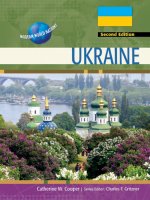- Trang chủ >>
- Khoa Học Tự Nhiên >>
- Vật lý
Modern world nations chile
Bạn đang xem bản rút gọn của tài liệu. Xem và tải ngay bản đầy đủ của tài liệu tại đây (14.79 MB, 139 trang )
CH.MWN.Chl.aFM.Final.q 2/20/04 8:24 PM Page 1
AFGHANISTAN
ARGENTINA
AUSTRALIA
AUSTRIA
BAHRAIN
BERMUDA
BOLIVIA
BOSNIA AND HERZEGOVINA
IRAQ
IRELAND
ISRAEL
ITALY
JAMAICA
JAPAN
KAZAKHSTAN
KENYA
BRAZIL
KUWAIT
CANADA
MEXICO
CHILE
THE NETHERLANDS
CHINA
NEW ZEALAND
COSTA RICA
CROATIA
NIGERIA
NORTH KOREA
CUBA
NORWAY
EGYPT
PAKISTAN
ENGLAND
PERU
ETHIOPIA
RUSSIA
FRANCE
REPUBLIC OF GEORGIA
SAUDI ARABIA
SCOTLAND
GERMANY
SOUTH AFRICA
GHANA
SOUTH KOREA
GUATEMALA
TAIWAN
ICELAND
TURKEY
INDIA
IRAN
UKRAINE
UZBEKISTAN
CH.MWN.Chl.aFM.Final.q 2/20/04 8:24 PM Page 2
CH.MWN.Chl.aFM.Final.q 2/20/04 8:24 PM Page 3
Chile
Richard A. Crooker
Kutztown University
Series Consulting Editor
Charles F. Gritzner
South Dakota State University
Philadelphia
CH.MWN.Chl.aFM.Final.q 2/20/04 8:24 PM Page 4
Frontispiece: Flag of Chile
Cover: Reflections of the Andes Mountains
CHELSEA HOUSE PUBLISHERS
VP, NEW PRODUCT DEVELOPMENT Sally Cheney
DIRECTOR OF PRODUCTION Kim Shinners
CREATIVE MANAGER Takeshi Takahashi
MANUFACTURING MANAGER Diann Grasse
Staff for CHILE
EXECUTIVE EDITOR Lee Marcott
PRODUCTION EDITOR Megan Emery
PICTURE RESEARCH 21st Century Publishing and Communications, Inc.
SERIES DESIGNER Takeshi Takahashi
COVER DESIGNER Keith Trego
LAYOUT 21st Century Publishing and Communications, Inc.
©2004 by Chelsea House Publishers, a subsidiary of Haights Cross Communications.
All rights reserved. Printed and bound in the United States of America.
First Printing
1 3 5 7 9 8 6 4 2
Library of Congress Cataloging-in-Publication Data
Crooker, Richard A.
Chile/by Richard A. Crooker.
v. cm.—(Modern world nations)
Includes bibliographical references and index.
Contents: Physical landscapes—Chile through time—People and culture—Government
and politics—Economy—Living in Chile today—Chile looks ahead.
ISBN 0-7910-7912-0
1. Chile—Juvenile literature. [1. Chile.] I. Title. II. Series.
F3058.5.C76 2004
983—dc22
2003028098
CH.MWN.Chl.aFM.Final.q 2/20/04 8:24 PM Page 5
Table of Contents
1 Introduction
8
2 Physical Landscapes
12
3 Chile Through Time
32
4 People and Culture
50
5 Government and Politics
66
6 Economy
82
7 Living in Chile Today
100
8 Chile Looks Ahead
116
Facts at a Glance
History at a Glance
Glossary
Further Reading
Websites
Index
120
122
124
127
127
128
CH.MWN.Chl.aFM.Final.q 2/20/04 8:24 PM Page 6
CH.MWN.Chl.aFM.Final.q 2/20/04 8:24 PM Page 7
Chile
CH.MWN.Chl.C01.Final.q 2/20/04 8:25 PM Page 8
1
Introduction
C
hile has a little of everything. It is rich in copper, fruits,
forests, and fish. It is a country of dramatic scenery and
many climates. Cool waters stroke its shore and icy glaciers
crown its peaks. Sighs of volcanoes and jolts of earthquakes shake its
ribs. Squeezed between the heights of the mountains and the depths
of the sea, Chile is a geologic marvel. Despite this physical diversity,
a sense of nationhood among its people unifies the country.
Chile is situated on the extreme southwestern coast of South
America. The Pacific Ocean lies to the west; Argentina and Bolivia are
to the east. No country in the world has such an extraordinary shape
as Chile. Its territory consists of a long, narrow ribbon of land that
runs north to south for approximately 2,700 miles (4,400 kilometers).
Its maximum width is barely 100 miles (160 kilometers). With an
area of 292,260 square miles (756,950 square kilometers), Chile is a
little smaller than Texas. The nation has the world’s driest desert and
8
CH.MWN.Chl.C01.Final.q
3/1/04
6:41 PM
Page 9
Chile is located on the southwestern coast of South America, with the Pacific
Ocean to the west and Argentina and Bolivia to the east. The country has a
very unusual shape, consisting of a narrow strip of land running approximately
2,700 miles (4,345 km) along the South American coast. However, its maximum
width is less than 100 miles (161 km) and its total area of 292,260 square
miles (756,950 square kilometers) makes it slightly smaller than Texas.
9
CH.MWN.Chl.C01.Final.q 2/20/04 8:25 PM Page 10
10
Chile
some of the highest mountains. Approximately 70 percent of
the land is mountainous, as the Andes Mountains extend the
length of the country and form a natural barrier between
Argentina and Bolivia.
Chile’s name has no connection with the Spanish word
“chili,” as in chili pepper, but the words are pronounced the
same. Most scholars believe that the name Chile comes from
a native Indian word—Tchilli, meaning “snow” or “cold.” The
Indians lived in a valley not far from where the country’s
capital and largest city, Santiago, is today. They named the
valley Tchilli because cold air and snow would blow into the
lowland from Andean peaks. The similarity in the meaning
of the native word Tchilli to the English word “chilly” is simply
a coincidence.
This odd-shaped country with a strange name is one of the
world’s most respected nations. Its history of political stability
is unmatched in Latin America. Its economic genius helped
ignite the global economy of the 1990s. It continues to have one
of the fastest growing economies in South America. It is also an
honest country, which for a developing nation is unusual. Taxes
are actually collected, the police generally do not seek or take
bribes, and most politicians are honest.
Chile’s location south of the equator means that its seasons
are the opposite of those of places like the United States and
Europe. Summer officially begins on December 21 and ends on
March 21. Winter begins on June 21 and continues until
September 21. The reversal in the timing of the summer and
winter seasons may not seem important at first. In some
respects, however, life in Chile is upside down compared to
ours. Chileans celebrate Christmas just like we do, only in the
hottest time of the year. Imagine decorating a Christmas tree
with tinsel and icicles in the heat of summer! On Christmas
Day, Chileans can enjoy picnics at the beach or meals in the
backyard. Pity the poor fathers who have to dress up in weighty
Santa Claus costumes in the summertime, though.
CH.MWN.Chl.C01.Final.q 2/20/04 8:25 PM Page 11
Introduction
Practically speaking, the opposite seasons help Chile’s
economy. In January, supermarkets in North America and
Europe are selling fruit plucked fresh a few weeks earlier in
Chile’s Central Valley and Andean foothills. In addition, skiers
in the United States and Europe come to Chile’s Andean ski
resorts from June to the middle of October to extend their
ski season.
Other nations envy Chile’s physical beauty, democratic
tradition, economic success, and attractive culture. Described
here is how geography and history converged to create the
nation of Chile, as well as an outline of its future problems
and prospects. This study begins by examining Chile’s diverse
physical landscapes, because the land is the stage on which a
nation plays out its unique existence.
11
CH.MWN.Chl.C02.Final.q 2/20/04 8:27 PM Page 12
2
Physical
Landscapes
T
hree major landform regions divide Chile: the Andes Mountains, the coast and islands, and the Central Valley. The regions
run north to south and parallel to each other. The Andes region
is an awesome mountain barrier. Its majestic peaks of spectacular
height and bone-chilling temperatures define the country’s eastern
border. The nation’s coast includes imposing sea cliffs, beautiful
beaches, low mountains, ice-scoured valleys, and sparsely settled
islands. Squeezed between the Andes and the coast is a long Central
Valley. Although Chile is a narrow country, its broad stretch of latitude
embraces a variety of climates, ranging from a parched north, a
temperate middle, and an extremely wet south. Spread over this crazyquilt geography is a variety of soils, plants, and animals.
THE ANDES
The high mountain range of the Andes (Cordillera de Los Andes
12
CH.MWN.Chl.C02.Final.q 2/20/04 8:27 PM Page 13
Chile’s unique shape results in a great variety of physical features in the
country. It boasts beaches, mountains, and ice fields, as well as multiple
distinct climates and diverse plant and animal species.
13
CH.MWN.Chl.C02.Final.q 2/20/04 8:27 PM Page 14
14
Chile
in Spanish) extends like a backbone through the entire length
of Chile, separating it from Argentina and Bolivia. Chile’s
northern Andes are an extension of the Bolivian altiplano
(Spanish for “high plain”). The altiplano is between 11,000 and
13,000 feet (3,350 to 4,000 meters) in elevation. Cold winds
are incessant, and they howl as they blow across the almost
featureless plain. The evenness of the general surface is
dramatic. Isaiah Bowman was the first U.S. geographer to
explore the region. Writing in the early 1900s, he reported that
the high plain looked “as if it were cut by a knife drawn along
the edge of a ruler.” Bowman aptly noted that the surface is not
entirely flat. A scattering of cone-shaped volcanoes, lava flows,
and mountain ridges rise above the altiplano’s generally level
surface, reaching 17,000 feet (5,600 meters) in some places.
Farther south is Chile’s central Andes region. This area has
some of the highest peaks in the world. Mount Aconcagua, the
highest summit (22,832 feet or 6,959 meters) in the Western
Hemisphere is just across the border in Argentina. Several other
prominent peaks are nearby. Together, these summits form one
of the most spectacular landscapes in Andean South America.
Yet, like forbidden fruit, the inviting summits have dangers,
such as landslides, avalanches, earthquakes, and volcanic
eruptions. Moreover, the heights endanger aircraft. Before the
arrival of passenger jets in the 1960s, pilots, unable to fly above
the mountains, had to wait for good weather and find a route
between peaks.
The peril of Andean aviation was made famous when, in
1972, a vintage propeller-driven plane carrying rugby players
from Uruguay crashed while attempting to fly across the Andes
to Santiago, Chile. Some of those aboard died, but others
survived the crash and for more than two months struggled
against bitter-cold temperatures before being rescued. A book
and a film titled Alive! immortalize this tragic story.
South of the central Andes, summits average about 6,500 feet
(2,000 meters), much lower than the northern and central Andes.
CH.MWN.Chl.C02.Final.q 2/20/04 8:27 PM Page 15
Physical Landscapes
The Andes Mountains extend through the entire length of Chile and
separate the country from its neighbors Argentina and Bolivia. The
mountain range has some of the highest peaks in the world as well
as many active volcanoes.
Geographers call the southern mountains the Patagonian Andes,
because the mountains are not much higher than Argentina’s
adjoining Patagonia Plateau. Summits are low in part because
15
CH.MWN.Chl.C02.Final.q 2/20/04 8:27 PM Page 16
16
Chile
of glacial erosion. During the Ice Age, erosion was widespread.
Ice fields (Campos de Hielos in Spanish) covered some mountain
ridges completely. The ice slowly whittled down summits by
plucking and scraping away rock. Today, only two ice fields
exist, but they account for nearly 60 percent of the region’s total
ice surface. Outlet glaciers from the ice fields and smaller valley
glaciers grow down the mountains to the ocean’s edge, where
they calve (break off) to form small icebergs.
The Andes Mountains are youthful because they are still
growing. Collisions of sections of Earth’s lithosphere (outer
rock layer) are causing the mountains to build up. (Geologists
call these “colliding sections plates.”) The collision involves
a large, westward-moving South American plate and three
plates that are moving eastward. Gravity is pulling the
smaller, heavier plates beneath the South American plate,
where they melt to form magma (molten rock). The collision
is also causing the western edge of South America to compress,
uplift, and fold to create the Andes Mountains. The magma
beneath the continent rises to the surface during explosive
volcanic eruptions.
Chile ranks fifth among nations in the number of active
volcanoes. (Geologists define active volcanoes as those that
have erupted within recent centuries.) Chile has 36 active
volcanoes; it is behind Russia (52) and ahead of Iceland (18).
The country’s main volcanoes are south of the latitude of
Santiago and include Cerro Azul, Llaima, Villarrica, and
Cerro Hudson. Villarrica, which is east of Puerto Montt
in southern Chile, is the most active volcano in South
America. It has been erupting fitfully since the early 1980s.
This peak is also Chile’s deadliest volcano. Eruptions in
1949, 1963, 1964, and 1971 caused mudflows that killed
75 people. Fortunately, this is a relatively small number of
deaths compared with those caused by volcanoes in other
regions of the world.
Chile’s landscape also experiences severe earthquakes caused
CH.MWN.Chl.C02.Final.q 2/20/04 8:27 PM Page 17
Physical Landscapes
by the strains of plate collision. Indeed, the coastal cities of
Valparaíso, Concepción, Valdivia, and Puerto Montt have been
leveled or severely shaken by earthquakes in the past 100 years.
One of the strongest temblors (earthquakes) of the twentieth
century struck in Chile on May 22, 1960. The earthquake
created a deadly tsunami (a superstrong ocean wave) that
traveled across the Pacific Ocean to Asia in just 24 hours.
The earthquake and tsunami killed more than 2,000 people
in Chile, Hawaii, Japan, and the Philippines. Because of
the unrelenting pressure from colliding plates, Chile will
continue to experience severe quakes.
Human use of the Chilean Andes varies among its subregions, depending on available resources. In the northern
altiplano region, the land is used in the summer to graze
livestock. In the winter, tourists take jeep excursions there.
The principle economic value of the northern Andes is its
water supply for towns in the region. Chile’s central and
southern Andes offer outdoor enthusiasts many pastimes.
Alpine scenery, trout-filled lakes and streams, and snowcovered slopes attract thousands of visitors each year. They
come to camp, fish, hike, climb, and ride horses and mountain
bikes. Whitewater rafting, water skiing, snow skiing, snowboarding, and paragliding are also popular. Chileans also
depend on the Andes’ natural resources. Melted water from
snow and ice feeds turbulent rivers. Hydroelectric dams on
several of these rivers not only provide electricity, but also
supply water to the nation’s farmers, homes, and industries.
Logging companies harvest the forests for their timber.
COAST AND ISLANDS
Chile and the other Andean countries have an emergent
coastline. As the western edge of South America rises out of the
sea, erosion and deposition by waves create narrow coastal
plains, sea cliffs, headlands, small beaches, and marine terraces.
The coastal plains are usually narrow, averaging less than 1 mile
17
CH.MWN.Chl.C02.Final.q 2/20/04 8:27 PM Page 18
18
Chile
(1.6 kilometers) wide. Where there is no plain, ocean and land
engage in a spirited battle. The unrelenting waves inevitably cut
wall-like sea cliffs into the land. Areas that are more resistant to
wave erosion become cliff-edged headlands (sections of land
that jut into the sea). Waves focus most of their rage on the
headlands. Between the promontories (land projecting into a
body of water), relatively calm waters deposit narrow, curving
strips of sandy beaches.
Over time, the relentless waves cut into the land to create
wave-planed submarine benches (flat areas). The benches become
a stair-step series of marine terraces (terrazas fluviomarinas)
above the water’s edge, as plate convergence gradually forces
them out of the sea. Some of these terraces, such as Antofagasta
and Tocopilla in northern Chile, are large enough for coastal
settlements. There are only a few good deepwater harbors.
They are all situated in valley openings that have protection
from storms.
Chile’s southern coastline begins south of Puerto Montt.
During the Ice Age, glaciers grew out of the southern Andes.
Westward-moving tongues of ice gouged huge depressions in
the Central Valley and coast range. After the Ice Age ended,
about 10,000 years ago, glaciers worldwide melted. The glacial
melt water poured into ocean basins to raise sea level to its
present height. Along Chile’s southern coast range, areas
that were not eroded by the ice became a forest-covered
chain of islands (archipelago). Ocean water filled the icescoured Central Valley, and narrow arms of the sea (fjords)
flooded into the glaciated valleys of the Andes. The rugged,
broken shoreline of Chile’s south bears a strong similarity
to other glaciated mountainous coastlines, such as those of
Norway and western Canada.
Chile’s coast range (cordillera de la Costa) rises abruptly
from the shoreline. The range consists of a narrow, leveltopped plateau. Elevations are greatest in the central area that
separates Santiago from Valparaíso, but heights never exceed
CH.MWN.Chl.C02.Final.q 2/20/04 8:27 PM Page 19
Physical Landscapes
6,500 feet (2,000 meters). The north to south trending range
gradually decreases in elevation from the central area to less
than 3,280 feet (1,000 meters) at both ends. The northern end
is at the Peru border. The southern end is the Zarao Mountains,
a north south spine of upland that runs down the middle of
Chiloé Island.
The country has many islands. Beginning at Chiloé, most
of them are strung out along the country’s glacially scoured
southern coast. Chile shares with Argentina the island of
Tierra del Fuego, which sits at the very southern end of South
America. The island’s name means “Land of Fire” in Spanish.
Chile also owns a number of oceanic islands. The San Félix and
San Ambrosio islands are roughly 465 miles (750 kilometers)
west of Chile. The Juan Fernández islands are about the
same distance away but farther south. The latter are known
for the fact that one of them was the home for five years
(1704 to 1709) of Alexander Selkirk. Selkirk was a foultempered, quarrelsome sailor; the captain of Selkirk’s ship
became fed up with him and marooned him on one of the
islands. Selkirk’s real-life experience became the basis for the
novel Robinson Crusoe, written by Daniel Defoe wrote in
1719. The classic story, which Defoe placed in the Caribbean
Sea, became so famous that the Chilean government
renamed Selkirk’s island Robinson Crusoe Island in the
mid-1970s.
Easter Island is also part of Chile. This solitary island is
famous for its monumental statues carved from the island’s
volcanic rocks. The origin of these statues is a mystery. This
tiny speck of land is 2,350 miles (3,780 kilometers) off the
Chilean coast. Because of its interesting monuments, Easter
Island has become an important stopover on South Pacific
airline routes.
THE CENTRAL VALLEY
The Central Valley is a series of long, narrow basins of
19
CH.MWN.Chl.C02.Final.q 2/20/04 8:27 PM Page 20
20
Chile
Chile’s long coastline and many islands are some of its most notable
characteristics. The country’s most famous island is Easter Island, seen
above, known for its mysterious statues of unknown origins carved
from volcanic rock.
different elevations. They are wedged between the coast range
and the Andes Mountains. The high basins are in northern
Chile. Andean streams have partially filled them with rock
debris of past geologic ages. Along the Andean edge of the
valley, waterborne gravel and coarse sand form huge, gently
sloping alluvial fans at the base of the eroding mountains.
CH.MWN.Chl.C02.Final.q 2/20/04 8:27 PM Page 21
Physical Landscapes
Andean streams have carried smaller size sediments—fine
sands, clays, and salts—down the alluvial fans and deposited
them in basin floors. These deposits form a crust of a rare
salt-bearing mineral. Since the nineteenth century, mining
operations have extracted sodium nitrate, a valuable mineral
for the manufacture of gunpowder and fertilizer, from the
deposits. The valley’s Andean edge has silver, gold, and copper
ore deposits. The deposits of copper are so huge that Chile is
the world’s leading producer of this metal. Copper and nitrate
mining camps are an important basis for settlement in Chile’s
desert north.
Water, like mining, has a primary influence on settlement.
Because streams are usually dry in the north, wells are dug
into the ground to tap into aquifers (porous layers of rock) that
store Andean water. Mining operations, mining towns and
camps, and small agricultural communities depend on this
groundwater and the water of intermittent streams.
The Central Valley basins in middle Chile are lower in
elevation than those in the north. Andean rivers with permanent, year-round flows have filled these basins with deep,
nutrient-rich layers of alluvium. The Aconcagua River drains
the northernmost basin; the Bío Bío River drains the southernmost depression. As you will see in coming chapters, this
relatively small area of Chile, aided by its mild climate, Andean
water supply, and fertile alluvial soils, is the nation’s chief
farming region and main population, economic, cultural, and
political center.
The Central Valley of southern Chile is south of the Bío Bío
River. The valley floor is closest to sea level there. Geographers
call most of this area the Lakes District, because hundreds of
small rivers and streams descend from the Andes to form lakes,
some quite large, in the lower elevations. Andean glaciers of the
Ice Age are responsible for the lakes. They eroded rock material
from the eastern mountains and carried the debris into the
valley. End moraines (mounds of material the size of small
21
CH.MWN.Chl.C02.Final.q 2/20/04 8:27 PM Page 22
22
Chile
hills left by glaciers) dam the streams to form the lakes. The
undulating surface of lake-filled basins, pastures, and low,
forest-covered moraines forms a picturesque landscape. The
natural beauty of this area makes it a popular destination for
tourists, mainly Chileans and Argentines who visit the area
during the summer.
WEATHER AND CLIMATE
Chile’s climates include a hot, parched desert—the
Atacama—in the north, a Mediterranean climate in the middle,
a marine (ocean-influenced) climate in the south, and a tundra
(subpolar) climate in the extreme south. Temperatures decrease
at increasingly higher latitudes (Table 1).
Table 1: Average Annual
Temperatures of Coastal Locations
LOCATION
LATITUDE
TEMPERATURE ºF (ºC)
Arica
18º S
67 (19)
Antofagasta
23º S
63 (17)
Valparaíso
33º S
58 (14)
Concepción
36º S
55 (13)
Valdivia
39º S
54 (12)
Puerto Montt
41º S
51 (11)
Puerto Aisén
45º S
48 (9)
Punta Arenas
53º S
44 (7)
Chileans refer to the Atacama Desert as El Norte Grande
(The Big North). A dry, subtropical, high-pressure air mass
sits stubbornly over the area all year. As a result, the region
receives less than 10 inches (250 millimeters) of precipitation.
In the lowlands, precipitation only occurs in the summer
CH.MWN.Chl.C02.Final.q 2/20/04 8:27 PM Page 23
Physical Landscapes
(December through February) when rare, but occasionally
fierce, thundershowers take place. The Atacama Desert is
renowned as the world’s driest desert. Arica has the world’s
lowest average annual precipitation, a scant 0.03 inches
(0.762 millimeters).
Nearby Iquique holds the record for the number of uninterrupted years without even a trace of rain: 14. Enough winter
snow falls in the peaks of the Andes to provide stream runoff
for farming in isolated oases in the low desert. The streams,
however, are ephemeral, meaning that they run for only short
periods. After a rain, the water comes to a stop, evaporates, or
seeps into the streambed and disappears. The Loa River is the
only stream with a permanent flow. It is large enough to flow
from the Andes across the desert to the ocean.
Chileans refer to the semiarid zone on the southern fringe
of the Atacama Desert as El Norte Chico (The Little North).
This zone is a transition from the arid desert to the more
humid climates of central and southern Chile. A small amount
of rainfall occurs in the winter, June through August, when
leftovers of Pacific cyclonic storms arrive. Several small rivers
(the Copiapó, Huasco, Elqui, Choapa, and Acongcagua) manage
to meander to the seashore. The arrival of these storms is
unreliable, so droughts occur every few years. Streams often
dry up, much to the dismay of farmers and ranchers.
Middle Chile has a Mediterranean climate. This type of
climate also exists around the shore of the Mediterranean
Sea (hence the name) and in California, South Africa, and
Australia. Mediterranean climates have mild, wet winters and
dry summers. Chile’s Mediterranean climate extends from the
port city of Valparaíso, which is at the mouth of the Aconguaga
River, to slightly south of the Bío Bío River. In winter, the edge
of the same subtropical high-pressure air mass that dominates
northern Chile shifts slightly north (toward the equator) and
away from middle Chile. The winter shift allows eastwardmoving cyclonic storms from the Pacific to pass over the region.
23
CH.MWN.Chl.C02.Final.q 2/20/04 8:27 PM Page 24
24
Chile
Because of mild temperatures, virtually all of the precipitation
comes as rain. In summer, December through February, the
edge of the high-pressure air mass shifts south (toward the
pole), over middle Chile and slightly beyond to Puerto Montt.
This shift forces the Pacific cyclonic storms farther south and
causes a dry summer. Rare thunderstorms bring brief periods
of relief to the dryness of summer. They also bring the threat of
forest fires in the Andes from lightning strikes.
The coast range affects middle Chile’s Mediterranean
climate. It forms a barrier that blocks the cool summer breeze
off the Pacific, making the summer temperatures on the coast
cooler than those in the Central Valley. As a result, Santiago,
which is in the valley, averages 16 days each summer with
temperatures greater than 90 °F (32 °C), whereas Concepción,
on the coast, has never recorded a temperature in the nineties.
The coast range also impedes moisture-bearing winter winds
blowing from the ocean. As a result, there is a “rain shadow” of
low precipitation in the Central Valley. The coastal areas
receive about 40 to 50 inches (1,000 to 1,300 millimeters),
whereas Santiago, located in the valley, receives only 11 inches
(280 millimeters) annually.
The high elevations of middle Chile’s central Andes are
too wet and cold to have a Mediterranean climate. Because
of the elevation, precipitation is greater than 100 inches
(2,500 millimeters) in some places, and it comes mainly in
the form of snow. In fact, transportation routes through the
mountain passes are typically closed in the winter due to
heavy snowstorms. The only all-season route to Argentina
is the Los Libertadores (The Liberators) tunnel northeast of
Santiago. As previously mentioned, snowfall above about
8,000 feet (3,500 meters) is sufficient to support the existence
of glaciers in this part of the Andes.
Southern Chile has a marine (ocean-influenced) climate.
Precipitation from Pacific cyclonic storms occurs there yearround. The storms form as a cold polar and warm tropical









